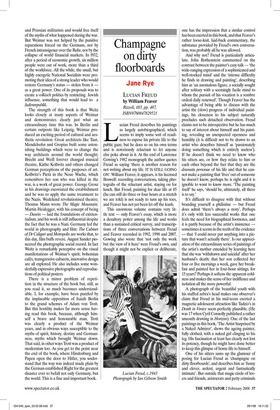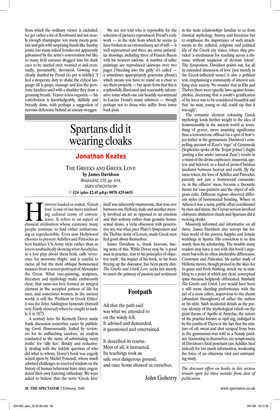Champagne on dirty floorboards
Jane Rye
LUCIAN FREUD by William Feaver Rizzoli, £65, pp. 487, ISBN9780847829521 Lucian Freud describes his paintings as largely autobiographical, which seems to imply some sort of readiness to expose his private life to the public gaze; but he does so on his own terms and is notoriously reluctant to let anyone else poke about in it. At the end of Lawrence Gowing’s 1982 monograph the author quotes Freud as saying ‘there is another reason for not writing about my life. IT IS STILL GOING ON’. William Feaver, it appears, is his licensed Boswell: recording conversations, taking photograhs of the reluctant artist, staying on for lunch. But Freud, painting for dear life at 85 (he can still do three or four hours at a stretch we are told) is not ready to turn up his toes, and Feaver has not yet been let off the leash.
This enormous volume contains very little text — only Feaver’s essay, which is more a desultory potter among the life and works than a sustained critical survey, and transcriptions of three conversations between Freud and Feaver recorded in 1992, 1998 and 2007. Gowing also wrote that ‘not only the work but the view of it here’ were Freud’s own, and though it might not be explicit or deliberate, one has the impression that a similar control has been exerted in this book, and that Feaver’s rather loose-knit, laid-back commentary, the substance provided by Freud’s own conversation, was probably all he was allowed.
And why not? Freud is particularly articulate. John Rothenstein commented on the contrast between the painter’s easy talk — ‘the wide-ranging expression of a sophisticated and well-stocked mind’ and the ‘intense difficulty he finds in drawing and painting’, describing him as ‘an anomalous figure, a socially sought after solitary with a seemingly facile mind to whom the pursuit of his vocation is a sombre ordeal daily renewed’. Though Feaver has the advantage of being able to discuss with the artist the (slow) progress of individual paintings, his closeness to his subject naturally precludes such detached observation. Freud claims not to be introspective but he has much to say of interest about himself and his painting, revealing an unexpected openness and humility (it is difficult not to be drawn to an artist who describes himself as ‘passionately doing something which is entirely useless’). If he doesn’t think we need to know who his sitters are, or how they relate to him or each other beyond the fact that they are the dramatis personae of his life and that he cannot make a painting that ‘lives’ out of someone he doesn’t know, perhaps he is right and it is ignoble to want to know more. ‘The painting itself’ he says, ‘should be, ultimately, all there is to say.’ It’s difficult to disagree with that without branding yourself a philistine — but Freud does admit ‘there’s always a story’. Perhaps it’s only with less successful works that one feels the need for biographical footnotes, and it is partly because of the artist’s insistence — sometimes it seems in the teeth of the evidence — that ‘I could never put anything into a picture that wasn’t actually there’. Is our appreciation of the extraordinary series of paintings of the artist’s mother extended by learning here that she was ‘withdrawn and suicidal’ after her husband’s death; that her son collected her four or five mornings a week, gave her breakfast and painted her in four-hour sittings, for 15 years? Perhaps it softens the apparent coldness and makes the sense of her indiffence and isolation all the more powerful.
A photograph of the beautiful youth with his stuffed zebra’s head makes one observer’s claim that Freud in his mid-teens exerted a magnetic adolescent attraction like Tadzio’s in Death in Venice seem perfectly plausible. (He was 17 when Cyril Connolly published a rather uncouth drawing in Horizon). One of the last paintings in this book, ‘The Artist Surprised by a Naked Admirer’, shows the ageing painter, fully clothed, with a naked girl clinging to his leg. His fascination at least has clearly not lost its potency, though he might have done better to keep this glimpse of home life to himself.
One of his sitters sums up the glamour of posing for Lucian Freud as ‘champagne on dirty floorboards’, and describes him as ‘funny and clever, ardent, urgent and fantastically intimate’. But outside that magic circle of lovers and friends, aristocrats and petty criminals from which the ordinary viewer is excluded, we get rather a lot of floorboard and not nearly enough champagne: too many meaty genitals and girls with surprising hands like Sunday joints; too many naked females not apparently galvanised by the artist’s conversation but like so many livid carcases dragged into his dank cave to be snarled over, worried at and eventually, presumably, devoured. Gowing was clearly dazzled by Freud (to put it mildly): ‘I feel a desperate duty to shake the critical language till is gasps; massage and kiss the prostrate faculties until with a shudder they draw a groaning breath.’ Feaver is less orgasmic — his contribution is knowledgeably, skilfully and breezily done, with perhaps a suggestion of nervous deference behind an uneasy swagger. We are not told who is reponsible for the selection of pictures reproduced. Freud’s early work — in the style from which he seems to have broken in an extraordinary act of will — is well represented and there are some unfamiliar drawings, including three of Francis Bacon with his trousers undone. A number of taller paintings are reproduced sideways over two pages (‘bleeding into the gully’ it’s called — a sometimes appropriately gruesome phrase) which means you have to stand on a chair to see them properly — but apart from that this is a splendidly illustrated and reasonably informative tome which one can heartily recommend to Lucian Freud’s many admirers — though perhaps not to those who suffer from lower back pain.



































































 Previous page
Previous page